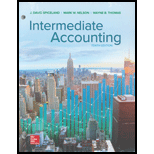
INTERMEDIATE ACCOUNTING <CUSTOM LL>
10th Edition
ISBN: 9781260887068
Author: SPICELAND
Publisher: MCG CUSTOM
expand_more
expand_more
format_list_bulleted
Concept explainers
Textbook Question
Chapter 8, Problem 8.4E
Perpetual and periodic inventory systems compared
• LO8–1
The following information is available for the Johnson Corporation for 2018:
| Beginning inventory | $ 25,000 |
| Merchandise purchases (on account) | 155,000 |
| Freight charges on purchases (paid in cash) | 10,000 |
| Merchandise returned to supplier (for credit) | 12,000 |
| Ending inventory | 30,000 |
| Sales (on account) | 250,000 |
| Cost of merchandise sold | 148,000 |
Required:
Applying both a perpetual and a periodic inventory system, prepare the
Expert Solution & Answer
Want to see the full answer?
Check out a sample textbook solution
Students have asked these similar questions
Please provide the correct answer to this general accounting problem using accurate calculations.
Please provide the correct answer to this general accounting problem using valid calculations.
Accounting?
Chapter 8 Solutions
INTERMEDIATE ACCOUNTING <CUSTOM LL>
Ch. 8 - Describe the three types of inventory of a...Ch. 8 - What is the main difference between a perpetual...Ch. 8 - The Cloud Company employs a perpetual inventory...Ch. 8 - The Bockner Company shipped merchandise to Laetner...Ch. 8 - What is a consignment arrangement? Explain the...Ch. 8 - Prob. 8.6QCh. 8 - The Esquire Company employs a periodic inventory...Ch. 8 - Prob. 8.8QCh. 8 - Its common in the electronics industry for unit...Ch. 8 - Explain why proponents of LIFO argue that it...
Ch. 8 - Prob. 8.11QCh. 8 - Describe the ratios used by financial analysts to...Ch. 8 - Prob. 8.13QCh. 8 - Prob. 8.14QCh. 8 - The Austin Company uses the dollar-value LIFO...Ch. 8 - Identify any differences between U.S. GAAP and...Ch. 8 - Determining ending inventory; periodic system ...Ch. 8 - Prob. 8.2BECh. 8 - LIFO method LO84 AAA Hardware uses the LIFO...Ch. 8 - LIFO liquidation LO86 Refer to the situation...Ch. 8 - Prob. 8.11BECh. 8 - Perpetual inventory system; journal entries LO81...Ch. 8 - Prob. 8.2ECh. 8 - Perpetual and periodic inventory systems compared ...Ch. 8 - Prob. 8.5ECh. 8 - Physical quantities and costs included in...Ch. 8 - FASB codification research LO82, LO83 Access the...Ch. 8 - Prob. 8.13ECh. 8 - Prob. 8.14ECh. 8 - Prob. 8.15ECh. 8 - Prob. 8.16ECh. 8 - Prob. 8.19ECh. 8 - Prob. 8.20ECh. 8 - Prob. 8.21ECh. 8 - Prob. 8.23ECh. 8 - Prob. 8.25ECh. 8 - Prob. 8.30ECh. 8 - Prob. 8.31ECh. 8 - Various inventory transactions; journal entries ...Ch. 8 - Prob. 8.3PCh. 8 - Prob. 8.4PCh. 8 - Various inventory costing methods LO81, LO84...Ch. 8 - Prob. 8.6PCh. 8 - Prob. 8.9PCh. 8 - Prob. 8.16PCh. 8 - Prob. 8.1DMPCh. 8 - Real World Case 82 Physical quantities and costs...Ch. 8 - Prob. 8.4DMPCh. 8 - Prob. 8.5DMPCh. 8 - Prob. 8.8DMPCh. 8 - Real World Case 89 Effects of inventory valuation...Ch. 8 - Communication Case 810 Dollar-value LIFO method ...Ch. 8 - Prob. 1CCTCCh. 8 - Prob. 2CCTC
Knowledge Booster
Learn more about
Need a deep-dive on the concept behind this application? Look no further. Learn more about this topic, accounting and related others by exploring similar questions and additional content below.Similar questions
- Please provide the accurate answer to this general accounting problem using appropriate methods.arrow_forwardI need help solving this general accounting question with the proper methodology.arrow_forwardI need guidance with this general accounting problem using the right accounting principles.arrow_forward
- Please help me solve this general accounting problem with the correct financial process.arrow_forwardI need help with this general accounting question using the proper accounting approach.arrow_forwardI am trying to find the accurate solution to this general accounting problem with appropriate explanations.arrow_forward
arrow_back_ios
SEE MORE QUESTIONS
arrow_forward_ios
Recommended textbooks for you
 Cornerstones of Financial AccountingAccountingISBN:9781337690881Author:Jay Rich, Jeff JonesPublisher:Cengage Learning
Cornerstones of Financial AccountingAccountingISBN:9781337690881Author:Jay Rich, Jeff JonesPublisher:Cengage Learning Intermediate Accounting: Reporting And AnalysisAccountingISBN:9781337788281Author:James M. Wahlen, Jefferson P. Jones, Donald PagachPublisher:Cengage LearningPrinciples of Accounting Volume 1AccountingISBN:9781947172685Author:OpenStaxPublisher:OpenStax College
Intermediate Accounting: Reporting And AnalysisAccountingISBN:9781337788281Author:James M. Wahlen, Jefferson P. Jones, Donald PagachPublisher:Cengage LearningPrinciples of Accounting Volume 1AccountingISBN:9781947172685Author:OpenStaxPublisher:OpenStax College Financial Accounting: The Impact on Decision Make...AccountingISBN:9781305654174Author:Gary A. Porter, Curtis L. NortonPublisher:Cengage Learning
Financial Accounting: The Impact on Decision Make...AccountingISBN:9781305654174Author:Gary A. Porter, Curtis L. NortonPublisher:Cengage Learning Financial And Managerial AccountingAccountingISBN:9781337902663Author:WARREN, Carl S.Publisher:Cengage Learning,
Financial And Managerial AccountingAccountingISBN:9781337902663Author:WARREN, Carl S.Publisher:Cengage Learning, Accounting (Text Only)AccountingISBN:9781285743615Author:Carl Warren, James M. Reeve, Jonathan DuchacPublisher:Cengage Learning
Accounting (Text Only)AccountingISBN:9781285743615Author:Carl Warren, James M. Reeve, Jonathan DuchacPublisher:Cengage Learning

Cornerstones of Financial Accounting
Accounting
ISBN:9781337690881
Author:Jay Rich, Jeff Jones
Publisher:Cengage Learning

Intermediate Accounting: Reporting And Analysis
Accounting
ISBN:9781337788281
Author:James M. Wahlen, Jefferson P. Jones, Donald Pagach
Publisher:Cengage Learning

Principles of Accounting Volume 1
Accounting
ISBN:9781947172685
Author:OpenStax
Publisher:OpenStax College

Financial Accounting: The Impact on Decision Make...
Accounting
ISBN:9781305654174
Author:Gary A. Porter, Curtis L. Norton
Publisher:Cengage Learning

Financial And Managerial Accounting
Accounting
ISBN:9781337902663
Author:WARREN, Carl S.
Publisher:Cengage Learning,

Accounting (Text Only)
Accounting
ISBN:9781285743615
Author:Carl Warren, James M. Reeve, Jonathan Duchac
Publisher:Cengage Learning
Chapter 6 Merchandise Inventory; Author: Vicki Stewart;https://www.youtube.com/watch?v=DnrcQLD2yKU;License: Standard YouTube License, CC-BY
Accounting for Merchandising Operations Recording Purchases of Merchandise; Author: Socrat Ghadban;https://www.youtube.com/watch?v=iQp5UoYpG20;License: Standard Youtube License